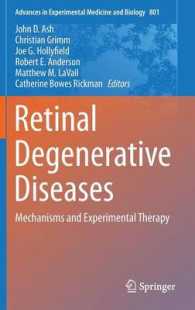Full Description
Retinal Degenerations is the result of The International Symposium on Retinal Degeneration which has become perhaps the most important research meeting in the field. The topics in this volume explore the etiology, cellular mechanisms, epidemiology, generics, models and potential therapeutic measures for the blinding diseases of retinitis pigmentosa and age-related macular degeneration.
Special focus is highlighted in the areas of Mechanisms of Photoreceptor Degeneration and Cell Death (extremely important because very little is known how or why photoreceptors die in these diseases, despite an abundance of genetic information), Age-Related Macular Degeneration (with several novel approaches to its analysis), Usher Syndrome (the most severe form of retinitis pigmentosa, which includes an early of congenital loss of hearing along with blindness), and Gene Therapy. In addition, the section on Basic Science Related to Retinal Degeneration is particularly strong with several laboratories reporting on new discoveries in the area of outer segment phagocytosis, a key component of photoreceptor-retinal pigment epithelial cell interactions in normal and degenerating retinas.
Contents
Keynote Lectures.- Curing Blindness with Stem Cells: Hope, Reality, and Challenges.- Retinal Degenerations: Planning for the Future.- Neuroprotection.- Neurotrophins Induce Neuroprotective Signaling in the Retinal Pigment Epithelial Cell by Activating the Synthesis nl of the Anti-inflammatory and Anti-apoptotic Neuroprotectin D1.- On the Role of CNTF as a Pontential Therapy for Retinal Degeneration: Dr. Jekyll or Mr. Hyde?.- Nanoceria Particles Prevent ROI-Induced Blindness.- An in-vivo Assay to Identify Compounds Protective Against Light Induced Apoptosis.- Role of BCL-XL in Photoreceptor Survival.- The Hypoxic Transcriptome of the Retina: Identification of Factors with Potential Neuroprotective Activity.- Gene Therapy and Neuroprotection.- Lentiviral Gene Transfer-Mediated Cone Vision Restoration in RPE65 Knockout Mice.- In vitro Analysis of Ribozyme-mediated Knockdown of an ADRP Associated Rhodopsin Mutation.- Gene Therapy for Mouse Models of ADRP.- Development of Viral Vectors with Optimal Transgene Expression for Ocular Gene Therapies.- Adeno-Associated Viral Vectors and the Retina.- Genetic Supplementation of RDS Alleviates a Loss-of-function Phenotype in C214S Model of Retinitis Pigmentosa.- of the Retina in the 4 Years Following rAAV-mediated Gene Transfer in the RPE65 Null Mutation Dog.- Virus-mediated Gene Delivery to Neuronal Progenitors.- Animal Models of Retinal Degeneration.- Loss of Visual and Retinal Function in Light-stressed Mice.- ERG Responses and Microarray Analysis of Gene Expression in a Multifactorial Murine Model of Age-Related Retinal Degeneration.- Oxygen Supply and Retinal Function: Insights from a Transgenic Animal Model.- Characterization of Gene Expression Profiles of Normal Canine Retina and Brain Using a Retinal cDNA Microarray.- Towarda Higher Fidelity Model of AMD.- The Potential of Ambient Light Restriction to Restore Function to the Degenerating P23H-3 Rat Retina.- Molecular Genetics and Candidate Genes.- Mutations in Known Genes Account for 58% of Autosomal Dominant Retinitis Pigmentosa (adRP).- Genetics of Age-related Macular Degeneration.- Retinal Phenotype of an X-Linked Pseudo-usher Syndrome in Association with the G173R Mutation in the RPGR Gene.- Mutation in the PYK2-Binding Domain of PITPNM3 Causes Autosomal Dominant Cone Dystrophy (CORD5) in Two Swedish Families.- Identification and Characterization of Genes Expressed in Cone Photoreceptors.- Clinical and Genetic Characterization of a Chinese Family with CSNB1.- 10q26 Is Associated with Increased Risk of Age-Related Macular Degeneration in the Utah Population.- Diagnostic, Clinical, Cytopathological and Physiologic Aspects of Retinal Degeneration.- Carboxyethylpyrrole Adducts, Age-related Macular Degeneration and Neovascularization.- A Possible Impaired Signaling Mechanism in Human Retinal Pigment Epithelial Cells from Patients with Macular Degeneration.- Expression and Cell Compartmentalization of EFEMP1, a Protein Associated with Malattia Leventinese.- Role of ELOVL4 in Fatty Acid Metabolism.- Organization and Molecular Interactions of Retinoschisin in Photoreceptors.- Basic Science Underlying Retinal Degeneration.- Proteomics Profiling of the Cone Photoreceptor Cell Line, 661W.- ?-Secretase Regulates VEGFR-1 Signalling in Vascular Endothelium and RPE.- Analysis of the Rate of Disk Membrane Digestion by Cultured RPE Cells.- Functional Expression of Cone Cyclic Nucleotide-Gated Channel in Cone Photoreceptor-Derived 661W Cells.- Phosphorylation of Caveolin-1 in Bovine Rod Outer Segments in vitro by an Endogenous Tyrosine Kinase.-Regulation of Neurotrophin Expression and Activity in the Retina.- Involvement of Guanylate Cyclases in Transport of Photoreceptor Peripheral Membrane Proteins.- Rod Progenitor Cells in the Mature Zebrafish Retina.- ?v?5 Integrin Receptors at the Apical Surface of the RPE: One Receptor, Two Functions.- Implantation of Mouse Eyes with a Subretinal Microphotodiode Array.- Variation in the Electroretinogram of C57BL/6 Substrains of Mouse.- A2E, A Pigment of RPE Lipofuscin, is Generated from the Precursor, A2PE by a Lysosomal Enzyme Activity.- Endothelin Receptors: Do They Have a Role in Retinal Degeneration?.- CNTF Negatively Regulates the Phototransduction Machinery in Rod Photoreceptors: Implication for Light-Induced Photostasis Plasticity.






